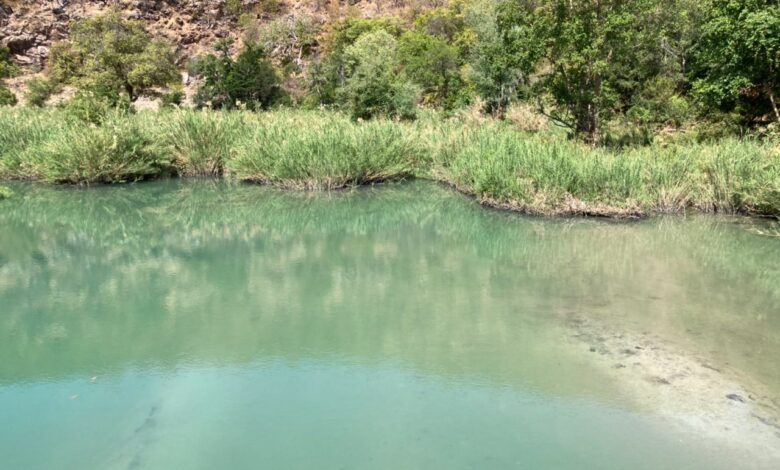The Ministry of Environment, Climate, and Wildlife has blamed legacy Acid Mine Drainage for Deka River pollution in Hwange and claims to have implemented several steps, including increased oversight, pollution control measures, and encouragement of sustainable mining technology to prevent further toxification.
The polluted Deka River has jeopardised the health of thousands of villagers, including their livestock and aquatic life in the river, which runs a few kilometres from Hwange Town and supplies water to villages such as Zwabo Mukuyu, Mashala, Shashachunda, Kasibo, and Mwemba before flowing into the Zambezi River.
Last year CITE investigated the pollution of the Deka River and tested water samples at a reputable laboratory in Bulawayo.
The tests confirmed the presence of industrial pollutants and total dissolved solids (TDS) in the river discharged by local and foreign-owned coal mining and power generation firms.
TDS are dissolved particles such as salts, minerals and metals found in all non-pure water sources. They were found to be above the permitted range for drinking water standards.
Read: https://cite.org.zw/deka-river-matabeleland-norths-river-of-pain/
However, the Minister of Environment, Climate and Wildlife, Dr Sithembiso Nyoni, said the pollution of Deka River is caused by a legacy issue caused by years of continuous discharge of Acid Mine Drainage (AMD) from the old Hwange Colliery Company (HCCL) workings contrary to popular belief, that the pollution is a result of the discharge of toxic chemicals by current mining companies.
Dr Nyoni disclosed this while responding to questions in Parliament recently on what measures the environment ministry is taking to stop mining companies and small-scale miners from discharging toxic chemicals into the Deka River.
She said there are three distinct AMD discharge points around Hwange and records show that by 1997, AMD was already a considerable problem.
“The initial interventions at the first and oldest discharge point started in 2008, involving the construction of a series of holding ponds to increase retention times and acid neutralisation using lime,” she said.
“Records indicate that on average, liming has helped increase the pH from around 2 to 3, and the holding ponds have since developed into an artificial wetland system.”
Dr Nyoni said the discharge rate at this site is variable, generally averaging about 16 cubic meters per day, with the pattern unrelated to natural seasons, suggesting it is not directly driven by rainwater recharge.
“At the second site, the rate of AMD discharge can be as high as about 200 cubic meters per day, with a pH as low as 2.7,” said the minister.
“The discharge pattern at this site is yet to be established, but it has generally been increasing over the years to the current rate. The third discharge point comprises two plugged exploration boreholes, through which the AMD is still seeping out, indicating significant pressure underground.”
Dr Nyoni said there exists a risk of new discharge points following the plugging of current ones, as records show a surge in AMD discharge at the second site after plugging the boreholes at the third.
“However, the efforts by the HCCL to mitigate the problem have fallen short. To address this challenge, the Ministry has implemented several measures to ensure mining activities do not compromise the integrity of water bodies like Deka River,” she said.
The measures cited by the minister include doing collaborative research on an in-depth study of the AMD problem.
“This is underway to develop a permanent solution. A comprehensive study plan outlining the work, equipment needs, and costs has been established,” Dr Nyoni said.
Secondly, the minister said they would strengthen oversight by intensifying monitoring, enforcement, and auditing of compliance with environmental regulations.
“Permits for responsible disposal of mining waste and chemicals are being implemented,” she said.
Dr Nyoni said in collaboration with the Ministry of Mines and Mining Development, stakeholder consultations with local authorities and community representatives is ongoing to raise awareness, establish joint task forces and act against offenders.
“Four on pollution control measures, we are mandating the implementation of appropriate pollution control measures such as tailings dams, waste treatment facilities and containment systems, as well as comprehensive environmental management plans for mining operations,” she said.
“Five for sustainable mining technologies, we are promoting cleaner and more sustainable mining technologies that minimise the use of toxic chemicals and reduce hazardous waste generation.
Six, local communities are being engaged through awareness campaigns to educate them about the risks associated with AMD discharge and the importance of protecting water resources. This empowers them to report illegal discharges or environmental violations.”
The minister claimed her ministry remains steadfastly committed to protecting the environment, safeguarding public health, and ensuring sustainable mining practices in our country.
“We will continue to take all necessary measures to prevent the discharge of toxic chemicals into Deka River and hold mining companies and small-scale miners accountable for any violations,” Dr Nyoni said.
“We are committed to seeing a measurable improvement in the river’s health in the near future.”

